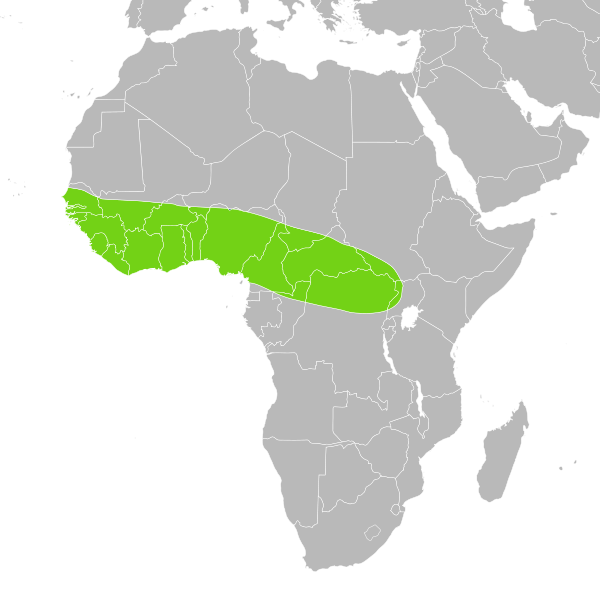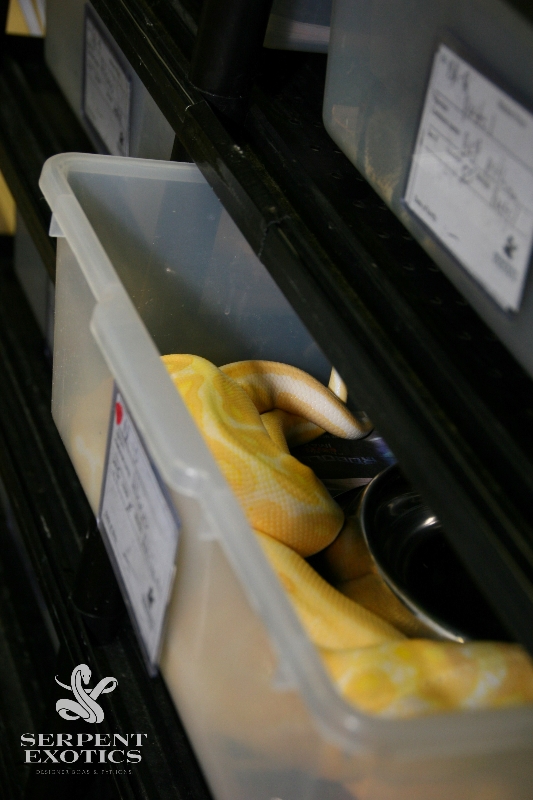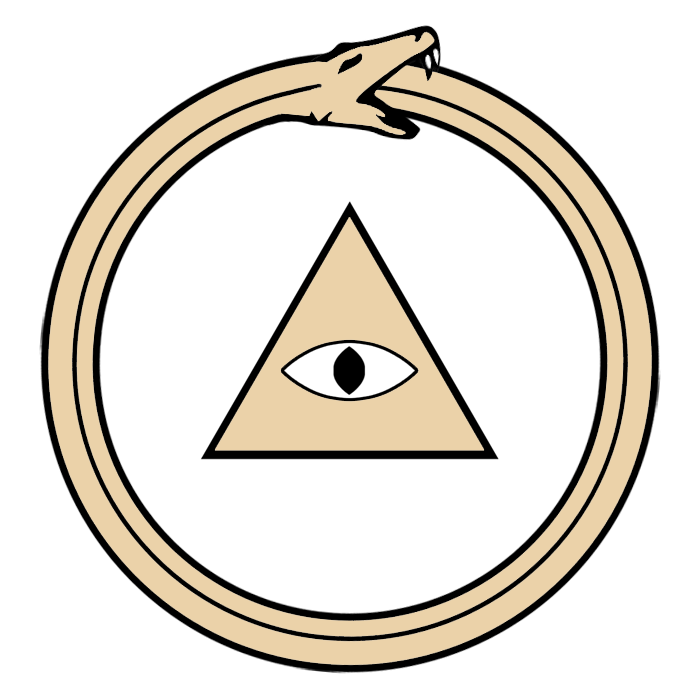


Python regius
Python regius
Scientific classification
Kingdom: Animalia
Phylum: Chordata
Subphylum: Vertebrata
Class: Reptilia
Order: Squamata
Suborder: Serpentes
Family: Pythonidae
Genus: Python
Species: P. regius
Binomial name
Python regius
(Shaw, 1802)
Python regius
Scientific classification
Kingdom: Animalia
Phylum: Chordata
Subphylum: Vertebrata
Class: Reptilia
Order: Squamata
Suborder: Serpentes
Family: Pythonidae
Genus: Python
Species: P. regius
Binomial name
Python regius
(Shaw, 1802)
Python regius is a nonvenomous python species found in Africa. This is the smallest of the African pythons and is popular in the pet trade, largely due to its typically docile temperament. No subspecies are currently recognized. It is also known as royal python or ball python. The name "ball python" refers to the animal's tendency to curl into a ball when stressed or frightened. The name "royal python" (from the Latin regius) is based in part on the story that Cleopatra supposedly wore the snake around her wrist.
Contents
1 Description
2 Geographic range
3 Habitat
4 Behavior
5 Feeding
6 Reproduction
7 Captivity
8 Beliefs and folklore
9 See also
10 References
11 External links
1 Description
2 Geographic range
3 Habitat
4 Behavior
5 Feeding
6 Reproduction
7 Captivity
8 Beliefs and folklore
9 See also
10 References
11 External links
Description
Adults generally do not grow to more than 90–120 cm (3.0–3.9 ft) in length, although some specimens have reached 152–182 cm (4.99–5.97 ft), but this is very rare.[5] Females tend to be slightly bigger than males, maturing at an average of 122–137 cm (4.00–4.49 ft). Males usually average around 90–107 cm (3.0–3.51 ft).[6] The build is stocky while the head is relatively small. The scales are smooth and both sexes have anal spurs on either side of the vent. Although males tend to have larger spurs, this is not definitive, and sex is best determined via manual eversion of the male hemipenes or inserting a probe into the cloaca to find the inverted hemipenes (if male). When probing to determine sex, males typically measure eight to ten subcaudal scales, and females typically measure two to four subcaudal scales.
The color pattern is typically black or dark brown with light brown or gold sides and dorsal blotches. The belly is a white or cream that may include scattered black markings. However, those in the pet industries have, through selective breeding, developed many morphs (genetic mutations) with altered colors and patterns.
Adults generally do not grow to more than 90–120 cm (3.0–3.9 ft) in length, although some specimens have reached 152–182 cm (4.99–5.97 ft), but this is very rare.[5] Females tend to be slightly bigger than males, maturing at an average of 122–137 cm (4.00–4.49 ft). Males usually average around 90–107 cm (3.0–3.51 ft).[6] The build is stocky while the head is relatively small. The scales are smooth and both sexes have anal spurs on either side of the vent. Although males tend to have larger spurs, this is not definitive, and sex is best determined via manual eversion of the male hemipenes or inserting a probe into the cloaca to find the inverted hemipenes (if male). When probing to determine sex, males typically measure eight to ten subcaudal scales, and females typically measure two to four subcaudal scales.
The color pattern is typically black or dark brown with light brown or gold sides and dorsal blotches. The belly is a white or cream that may include scattered black markings. However, those in the pet industries have, through selective breeding, developed many morphs (genetic mutations) with altered colors and patterns.
Geographic range
They are found in Africa from Senegal, Mali,
Guinea-Bissau, Guinea, Sierra Leone, Liberia,
Ivory Coast, Ghana, Benin, and Nigeria through
Cameroon, Chad and the Central African Republic
to Sudan and Uganda. No type locality was
given in the original description.
Habitat
Ball pythons prefer grasslands, savannas and sparsely wooded areas.
Behavior
This terrestrial species is known for its defense strategy that involves coiling into a tight ball when threatened, with its head and neck tucked away in the middle. In this state, it can literally be rolled around. Favored retreats include mammal burrows and other underground hiding places, where they also aestivate. In captivity, they are considered good pets, for their relatively small size and placid nature making them easy to handle. Captive bred adults rarely bite.
They are found in Africa from Senegal, Mali,
Guinea-Bissau, Guinea, Sierra Leone, Liberia,
Ivory Coast, Ghana, Benin, and Nigeria through
Cameroon, Chad and the Central African Republic
to Sudan and Uganda. No type locality was
given in the original description.
Habitat
Ball pythons prefer grasslands, savannas and sparsely wooded areas.
Behavior
This terrestrial species is known for its defense strategy that involves coiling into a tight ball when threatened, with its head and neck tucked away in the middle. In this state, it can literally be rolled around. Favored retreats include mammal burrows and other underground hiding places, where they also aestivate. In captivity, they are considered good pets, for their relatively small size and placid nature making them easy to handle. Captive bred adults rarely bite.
Feeding
In the wild, their diet consists mostly of small mammals, such as African soft-furred rats, shrews and striped mice. Younger individuals have also been known to feed on birds. Pythons imported from the wild tend to be picky eaters and may not respond to food as well as captive-bred pythons, which usually do well on domestic rats and mice, either live, killed, or frozen-thawed. Live feeding a snake can be dangerous for the snake involved and should never be attempted by inexperienced keepers; it should only ever be a last resort for a snake which has not eaten for a considerable amount of time, and has lost weight. The size of the prey item given to a python should be equivalent to or slightly larger than the width of the largest part of its body. This python is known for being a picky eater and may not eat for months, particularly during the winter breeding season. While this is not odd, care should be taken to watch that the snake does not experience significant weight loss. Parasites can also cause the snake to not eat. Other causes of not eating are stress caused by over handling, or too hot or cold temperatures and not enough areas to hide in the vivarium.
In the wild, their diet consists mostly of small mammals, such as African soft-furred rats, shrews and striped mice. Younger individuals have also been known to feed on birds. Pythons imported from the wild tend to be picky eaters and may not respond to food as well as captive-bred pythons, which usually do well on domestic rats and mice, either live, killed, or frozen-thawed. Live feeding a snake can be dangerous for the snake involved and should never be attempted by inexperienced keepers; it should only ever be a last resort for a snake which has not eaten for a considerable amount of time, and has lost weight. The size of the prey item given to a python should be equivalent to or slightly larger than the width of the largest part of its body. This python is known for being a picky eater and may not eat for months, particularly during the winter breeding season. While this is not odd, care should be taken to watch that the snake does not experience significant weight loss. Parasites can also cause the snake to not eat. Other causes of not eating are stress caused by over handling, or too hot or cold temperatures and not enough areas to hide in the vivarium.
Reproduction
Females are oviparous, with anywhere from 3 to 11 rather large, leathery eggs being laid (4-6 being most common). These are incubated by the female under the ground, and hatch after 55 to 60 days. Sexual maturity is reached at 11–18 months for males, and 20–36 months for females. Age is only one factor in determining sexual maturity and ability to breed – weight is the second factor. Males will breed at 600 grams or more, but in captivity are often not bred until they are 800 grams (1.7 lb), and females will breed in the wild at weights as low as 800 grams, though 1200 grams or more is most common; in captivity, breeders generally wait until they are no less than 1500 g (3.3 lb). Parental care of the eggs ends once they hatch, and the female leaves the offspring to fend for themselves.
Females are oviparous, with anywhere from 3 to 11 rather large, leathery eggs being laid (4-6 being most common). These are incubated by the female under the ground, and hatch after 55 to 60 days. Sexual maturity is reached at 11–18 months for males, and 20–36 months for females. Age is only one factor in determining sexual maturity and ability to breed – weight is the second factor. Males will breed at 600 grams or more, but in captivity are often not bred until they are 800 grams (1.7 lb), and females will breed in the wild at weights as low as 800 grams, though 1200 grams or more is most common; in captivity, breeders generally wait until they are no less than 1500 g (3.3 lb). Parental care of the eggs ends once they hatch, and the female leaves the offspring to fend for themselves.
Captivity
These snakes are bred in captivity and are popular as pets, because of their small size (compared to other pythons) and their docile temperament. Wild-caught specimens have greater difficulty adapting to a captive environment, which can result in refusal to feed, and they generally carry internal or external parasites which must be eliminated by administering anti-parasitic drugs. Specimens have survived for over 40 years in captivity, with the oldest recorded ball python being more than 48 years old. In captivity, most adult Python regius snakes should be kept in a minimum of a 25 US gallons (90 L), long glass tank, as these pythons are ground dwellers and are highly secretive and largely sedentary. Some large females may require cages up to the 40 US gallons (150 L) long tank. Also, at least two hiding places should be provided at different ends of the tank, one should have a thermostat-controlled heating pad under it to allow the animal to regulate its temperature. Since most snakes are adept at escaping captivity, the tank should have a locking lid. Juveniles in particular may be stressed by overly large cages that do not have sufficient small hiding spaces. For this reason, baby ball pythons do well in a 5 US gallons (19 L) or 10 US gallons (38 L) cage at first. Controlled temperatures of 80 °F (27 °C) with a 90 °F (32 °C) basking area on one end of the cage are necessary for proper health. Humidity should be maintained at 50% to 60% with dry substrate.

Beliefs and folklore
This species is particularly revered in the traditional religion of the Igbo people of southeastern Nigeria. It is considered symbolic of the earth, being an animal that travels so close to the ground. Even among many Christian Igbos, these pythons are treated with great care whenever they happen to wander into a village or onto someone's property; they are allowed to roam freely or are very gently picked up and placed out in a forest or field away from any homes. If one is accidentally killed, many communities in Igboland will still build a coffin for the snake's remains and give it a short funera

© 2010 Serpentexotics. All rights reserved.
Montreal, Quebec, Canada | 514-641-6046| e-mail: serpentexotics@gmail.com
Montreal, Quebec, Canada | 514-641-6046| e-mail: serpentexotics@gmail.com
